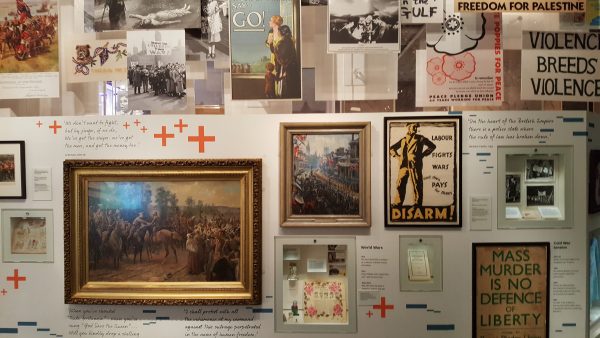“It’s difficult to understand the history of Britain, if you don’t understand the history of the British Army”, Janice Murray, Director General of the refurbished National Army Museum, said at its reopening.
A grand statement, but not entirely exaggerated, for the punctuation marks in the long timeline of the UK are often military. The history lessons at school focus on the big events, the battles, the wars, the victories and defeats.
In that sense, a failure to understand the form and function of the military who carry out those conflicts is indeed to leave your understanding of history incomplete.
It’s to show off that history, in all its shades, that has seen the museum undergo a massive refit. Away with the slightly oppressive glazed brick and clay brick frontage, and in with sheets of glass and a new easier to find entrance.
Out went the often confusing maze of small rooms and dark corners, and in comes a design that is more thematic than chronological.
Although their descriptions differ, it can be said to be: the army history, the army within society, the army at work, the army abroad and the army in art.
The museum is also no longer laid out in an obvious route, being a series of large rooms leading off from the central atrium, letting people pick and mix how they move around the space rather than being corralled along a route designed by the curators.
Military museums rarely glorify war, but they do celebrate the institution of military service, and here, you can expect a lot of uniforms, lots of medals and lots of historic paintings.
My slight disappointment is that the museum falls into the trap of many military museums, that it focuses on the actions of the army. The battles, the equipment for battles, the uniforms for battles, the dreadful aftermath of those battles.
However, for the average soldier, conflict has been a rare event. Life in the army is a perpetual state of limbo, preparing for overseas fights that the very presence of the army in far flung corners of the world often deters.
The army has long been a deterrent, and the long tedium of military life is rarely covered by military museums. Unsurprisingly really, as most of us want big bangs, big guns and big battles.
The museum does touch on the complaints of soldier’s life — the food being unpalatable, the heavy packs they have to carry, the lack of privacy and facilities.
More suited to modern sensibilities though, they don’t shy away from the darker side of military life. The physiological damage done by conflict, how society itself can rebel against military action and protest against war.
Possibly the most powerful object in the entire display at the moment is a work of art that is both aesthetically beautiful, but haunting for both how its made, and by the fact that it’s by a former soldier who suffered serious problems after he left the institution that is military life.
Overall, the decision to split the display up into five zones is an inspired one, as it makes it easier to dip into the museum for semi-regular short visits, taking in the whole more slowly.
That’s it’s free to visit assists that — otherwise you’d want to take in everything in one visit, which is a bit overkill for a venue this size.
A nice touch is that the display cases have been deliberately designed to be easy to change, and many of them are both informative, but also pointers to the nearby digital screens which makes a much larger catalogue of information available to the determined visitor.
What you won’t find here is a large collection of big machines. This is a museum of the soldier, the person rather than the machine. A few machines add some colour to the display, and there’s a mock-up tank for kids to play in.
But really, this museum focuses on the people who made up the army. The people who manned the barracks and fought the wars.
In that sense, its why understanding the army is so important. It’s the only one of the services not to be Royal, as it was created by Parliament, and it’s the only one that can be found in such geographically wide a remit.
The Navy tends to like shorelines, the RAF likes airfields. The army is boots on the ground, whether in the many UK barracks, or getting close up and personal around the world.
Britannia ruled the waves, but it was the army that controlled the Empire.
The National Army Museum reopens on Thursday, and will be open every day 10am-5:30pm, with a late opening on the first Wednesday of each month until 8pm.




















Where is this museum please?
Can you say what its near and directions from tube if possible.
Many thanks in advance.
Janice
Royal Hospital Road, Chelsea.
Use the link in the text to get to their website.